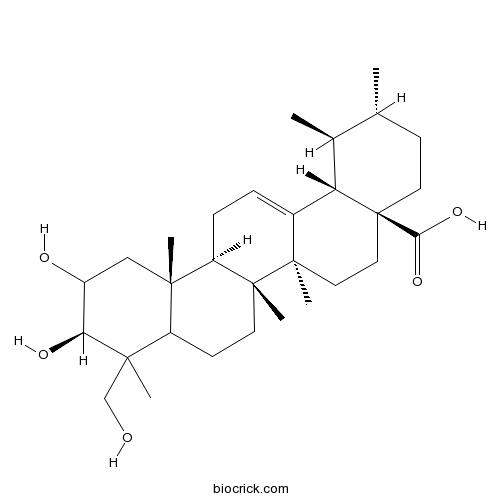2,24-Dihydroxyursolic acidCAS# 143839-02-5 |

- Esculentic acid
Catalog No.:BCN5856
CAS No.:103974-74-9
- Asiatic acid
Catalog No.:BCN5506
CAS No.:464-92-6
- 2,3,24-Trihydroxy-12-ursen-28-oic acid
Catalog No.:BCN1314
CAS No.:89786-83-4
Quality Control & MSDS
3D structure
Package In Stock
Number of papers citing our products

| Cas No. | 143839-02-5 | SDF | Download SDF |
| PubChem ID | 73554050 | Appearance | Powder |
| Formula | C30H48O5 | M.Wt | 488.7 |
| Type of Compound | Triterpenoids | Storage | Desiccate at -20°C |
| Solubility | Soluble in Chloroform,Dichloromethane,Ethyl Acetate,DMSO,Acetone,etc. | ||
| Chemical Name | (1S,2R,4aS,6aR,6aS,6bR,10R,12aR,14bS)-10,11-dihydroxy-9-(hydroxymethyl)-1,2,6a,6b,9,12a-hexamethyl-2,3,4,5,6,6a,7,8,8a,10,11,12,13,14b-tetradecahydro-1H-picene-4a-carboxylic acid | ||
| SMILES | CC1CCC2(CCC3(C(=CCC4C3(CCC5C4(CC(C(C5(C)CO)O)O)C)C)C2C1C)C)C(=O)O | ||
| Standard InChIKey | JXSVIVRDWWRQRT-MRWSKXGLSA-N | ||
| General tips | For obtaining a higher solubility , please warm the tube at 37 ℃ and shake it in the ultrasonic bath for a while.Stock solution can be stored below -20℃ for several months. We recommend that you prepare and use the solution on the same day. However, if the test schedule requires, the stock solutions can be prepared in advance, and the stock solution must be sealed and stored below -20℃. In general, the stock solution can be kept for several months. Before use, we recommend that you leave the vial at room temperature for at least an hour before opening it. |
||
| About Packaging | 1. The packaging of the product may be reversed during transportation, cause the high purity compounds to adhere to the neck or cap of the vial.Take the vail out of its packaging and shake gently until the compounds fall to the bottom of the vial. 2. For liquid products, please centrifuge at 500xg to gather the liquid to the bottom of the vial. 3. Try to avoid loss or contamination during the experiment. |
||
| Shipping Condition | Packaging according to customer requirements(5mg, 10mg, 20mg and more). Ship via FedEx, DHL, UPS, EMS or other couriers with RT, or blue ice upon request. | ||
| Description | 1. 2,24-Dihydroxyursolic acid shows DPPH free radical scavenging and superoxide anion scavenging activity. |

2,24-Dihydroxyursolic acid Dilution Calculator

2,24-Dihydroxyursolic acid Molarity Calculator
| 1 mg | 5 mg | 10 mg | 20 mg | 25 mg | |
| 1 mM | 2.0462 mL | 10.2312 mL | 20.4625 mL | 40.9249 mL | 51.1561 mL |
| 5 mM | 0.4092 mL | 2.0462 mL | 4.0925 mL | 8.185 mL | 10.2312 mL |
| 10 mM | 0.2046 mL | 1.0231 mL | 2.0462 mL | 4.0925 mL | 5.1156 mL |
| 50 mM | 0.0409 mL | 0.2046 mL | 0.4092 mL | 0.8185 mL | 1.0231 mL |
| 100 mM | 0.0205 mL | 0.1023 mL | 0.2046 mL | 0.4092 mL | 0.5116 mL |
| * Note: If you are in the process of experiment, it's necessary to make the dilution ratios of the samples. The dilution data above is only for reference. Normally, it's can get a better solubility within lower of Concentrations. | |||||

Calcutta University

University of Minnesota

University of Maryland School of Medicine

University of Illinois at Chicago

The Ohio State University

University of Zurich

Harvard University

Colorado State University

Auburn University

Yale University

Worcester Polytechnic Institute

Washington State University

Stanford University

University of Leipzig

Universidade da Beira Interior

The Institute of Cancer Research

Heidelberg University

University of Amsterdam

University of Auckland

TsingHua University

The University of Michigan

Miami University

DRURY University

Jilin University

Fudan University

Wuhan University

Sun Yat-sen University

Universite de Paris

Deemed University

Auckland University

The University of Tokyo

Korea University
- Fmoc-Trp(Boc)-OH
Catalog No.:BCC3558
CAS No.:143824-78-6
- 22-Dehydroclerosterol glucoside
Catalog No.:BCN6243
CAS No.:143815-99-0
- 13-Epimanool
Catalog No.:BCN4862
CAS No.:1438-62-6
- SB 200646 hydrochloride
Catalog No.:BCC5751
CAS No.:143797-62-0
- 3-O-Coumaroylasiatic acid
Catalog No.:BCN7132
CAS No.:143773-52-8
- (RS)-Abscisic acid
Catalog No.:BCN8353
CAS No.:14375-45-2
- PACAP 6-38
Catalog No.:BCC7611
CAS No.:143748-18-9
- Pyrazine-2-carbaldehyde
Catalog No.:BCN2565
CAS No.:5780-66-5
- Kaempferol 3,4,7-triacetate
Catalog No.:BCN6242
CAS No.:143724-69-0
- Soyasaponin Bd
Catalog No.:BCN2465
CAS No.:135272-91-2
- CE3F4
Catalog No.:BCC5605
CAS No.:143703-25-7
- GYKI 53655 hydrochloride
Catalog No.:BCC7407
CAS No.:143692-48-2
- CC-401 hydrochloride
Catalog No.:BCC1458
CAS No.:1438391-30-0
- Elacridar hydrochloride
Catalog No.:BCC1547
CAS No.:143851-98-3
- M40
Catalog No.:BCC7686
CAS No.:143896-17-7
- CB-839
Catalog No.:BCC5493
CAS No.:1439399-58-2
- Jaceidin triacetate
Catalog No.:BCN6245
CAS No.:14397-69-4
- CTX0294885
Catalog No.:BCC6396
CAS No.:1439934-41-4
- Sodium barbital
Catalog No.:BCN2160
CAS No.:144-02-5
- Sodium bicarbonate
Catalog No.:BCC7584
CAS No.:144-55-8
- Oxalic acid
Catalog No.:BCN8515
CAS No.:144-62-7
- Zeaxanthin
Catalog No.:BCN2380
CAS No.:144-68-3
- Sulfathiazole sodium
Catalog No.:BCC5207
CAS No.:144-74-1
- Sulfamethizole
Catalog No.:BCC4856
CAS No.:144-82-1
Antioxidant caffeic acid derivatives from leaves of Parthenocissus tricuspidata.[Pubmed:15089035]
Arch Pharm Res. 2004 Mar;27(3):300-4.
Five caffeic acid derivatives; methyl ester of caffeoylglycolic acid (1), dimethyl ester of caffeoyltartaric acid (2), dimethyl ester of caffeoyltartronic acid (3), monomethyl ester of caffeoyltartronic acid (4), methyl ester of caffeic acid (5), and some other secondary metabolites including; quercetin, quercetin 3-O-beta-D-glucuronide methyl ester, kaempferol, 3,5,7,4'-O-tetramethylkaempferol, beta-sitosterol glucoside, 2alpha-hydroxyursolic acid and 2,24-Dihydroxyursolic acid, have been isolated and characterized. All the isolated compounds were characterized with the help of NMR spectroscopy and mass spectrometry. Structure of compound 3 was also confirmed by a single X-ray crystallographic technique. Isolates were evaluated for antioxidant activities and most of the tested compounds were found to be potent in DPPH free radical scavenging (IC50 = 4.56-14.17 microg/mL) and superoxide anion scavenging (IC50 = 0.58-7.39 microg/mL) assays.


